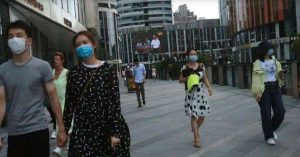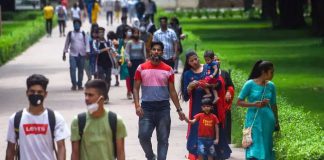JULY 30, 2020

China has seen 84,165 coronavirus cases thus far with only 4,634 deaths.(Reuters)
No large country in the world has been able to contain the disease to one restricted geography the way China has.
According to worldometers.info, it has seen 84,165 cases of the coronavirus disease thus far with only 4,634 deaths. It has only 574 active cases of the disease (all data is till late evening of July 29). Merely by looking at the numbers it is difficult to imagine that the disease which has infected more than 17 million people worldwide, killing close to 670,000 (including over 4.4 million cases and 150,000 deaths in the US, and close to 1.6 million cases and almost 35,000 deaths in India) actually originated in Wuhan, China, from where it travelled, through people, all over the world. Sure there has been a minor flurry of cases in Beijing, but the numbers are far too small to suggest any sort of outbreak.
One theory is that the Chinese have completely buried all inconvenient information related to the disease and its fallout within the country. This is true at least in part; Beijing has steadfastly sidestepped calls for a scientific investigation into the origin of the virus. But there is nothing to suggest that it has engaged in a massive cover-up to hide outbreaks in other parts of the country.
Which is why its Covid-19 numbers are a mystery. This column has pointed out that the pandemic has followed roughly the same trajectory in most countries. It has also pointed out that its trajectory has been similar in large countries such as the US, Brazil, and India, with concentrated outbreaks in a few areas that gradually spread to other areas, which then started seeing similar outbreaks. China is the world’s most populous country and the third largest country by geographical area. The US is the fourth largest, Brazil the fifth, and India the seventh (India is the second most populous country in the world, the US the third, and Brazil the sixth).
A recent paper in Science may have the answer. According to the paper, by Benjamin Cowling and other researchers, mostly at the University of Hong Kong, China’s ability to stop Covid-19 in its tracks may have to do with its ability to manage the serial interval. In epidemiology, the serial interval is the gap between the onset of symptoms in Person A, and Person B, who is infected by Person A. The researchers’ main finding is the title of the paper: “Serial interval of SARS-CoV-2 was shortened over time by nonpharmaceutical interventions”.
The researchers found that the serial interval in Wuhan came down from 7.8 days to 2.6 days between early January and early February. They hypothesise that this was made possible by China’s aggressive contact tracing, quarantine, and isolation protocols, which meant that all infections arising from one infected individual happened in a short period of time (in this case, 2.6 days), thereby ensuring that infected people, because they were isolated, could not infect any more people later in the infection cycle. The result, according to the researchers, was fewer cases. The sooner an infected person was isolated, the researchers found, the shorter was the serial interval. Their paper also explains that the serial interval is related to other epidemiological parameters, such as the attack rate of a virus (the proportion of people exposed to the virus over a period of time) and the reproduction rate or R naught, the number of people who will be infected by one infected person.
At this point, what Cowling and Co have proposed is a theory (backed by data and research), albeit a very plausible one.
It is also one that emphasizes the only way to deal with the coronavirus disease in the absence of a vaccine or a cure – test, trace, and isolate. And it is proof that better tracing and prompt (and stringent) isolation can lead to flatter infection curves.
Follow the government’s latest guidance on safeguarding yourself during the coronavirus pandemic, including travel advice within and outside the country. The World Health Organization has also busted some myths surrounding coronavirus. The Ministry of Health’s special helpline is available at +91-11-23978046, ncov2019@gmail.com and ncov2019@gov.in.
Courtesy/Source: Hindustan Times








































































































